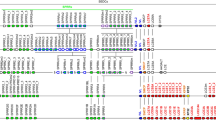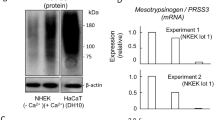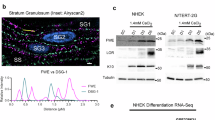Abstract
A specialized tissue type, the keratinizing epithelium, protects terrestrial mammals from water loss and noxious physical, chemical and mechanical insults. This barrier between the body and the environment is constantly maintained by reproduction of inner living epidermal keratinocytes which undergo a process of terminal differentiation and then migrate to the surface as interlocking layers of dead stratum corneum cells. These cells provide the bulwark of mechanical and chemical protection, and together with their intercellular lipid surroundings, confer water-impermeability. Much of this barrier function is provided by the cornified cell envelope (CE), an extremely tough protein/lipid polymer structure formed just below the cytoplasmic membrane and subsequently resides on the exterior of the dead cornified cells. It consists of two parts: a protein envelope and a lipid envelope. The protein envelope is thought to contribute to the biomechanical properties of the CE as a result of cross-linking of specialized CE structural proteins by both disulfide bonds and N(ε)-(γ-glutamyl)lysine isopeptide bonds formed by transglutaminases. Some of the structural proteins involved include involucrin, loricrin, small proline rich proteins, keratin intermediate filaments, elafin, cystatin A, and desmosomal proteins. The lipid envelope is located on the exterior of and covalently attached by ester bonds to the protein envelope and consists of a monomolecular layer of ω-hydroxyceramides. These not only serve of provide a Teflon-like coating to the cell, but also interdigitate with the intercellular lipid lamellae perhaps in a Velcro-like fashion. In fact the CE is a common feature of all stratified squamous epithelia, although its precise composition, structure and barrier function requirements vary widely between epithelia. Recent work has shown that a number of diseases which display defective epidermal barrier function, generically known as ichthyoses, are the result of genetic defects of the synthesis of either CE proteins, the transglutaminase 1 cross-linking enzyme, or defective metabolism of skin lipids.
Similar content being viewed by others
Article PDF
Author information
Authors and Affiliations
Rights and permissions
This is an Open Access article distributed under the terms of the Creative Commons Attribution Non-Commercial License (http://creativecommons.org/licenses/by-nc/3.0/) which permits unrestricted non-commercial use, distribution, and reproduction in any medium, provided the original work is properly cited.
About this article
Cite this article
Nemes, Z., Steinert, P. Bricks and mortar of the epidermal barrier. Exp Mol Med 31, 5–19 (1999). https://doi.org/10.1038/emm.1999.2
Published:
Issue date:
DOI: https://doi.org/10.1038/emm.1999.2
This article is cited by
-
Ichthyosis
Nature Reviews Disease Primers (2023)
-
Contribution of autofluorescence from intracellular proteins in multiphoton fluorescence lifetime imaging
Scientific Reports (2022)
-
Enhancement strategies for transdermal drug delivery systems: current trends and applications
Drug Delivery and Translational Research (2022)
-
Phytosphingosine enhances moisture level in human skin barrier through stimulation of the filaggrin biosynthesis and degradation leading to NMF formation
Archives of Dermatological Research (2017)



